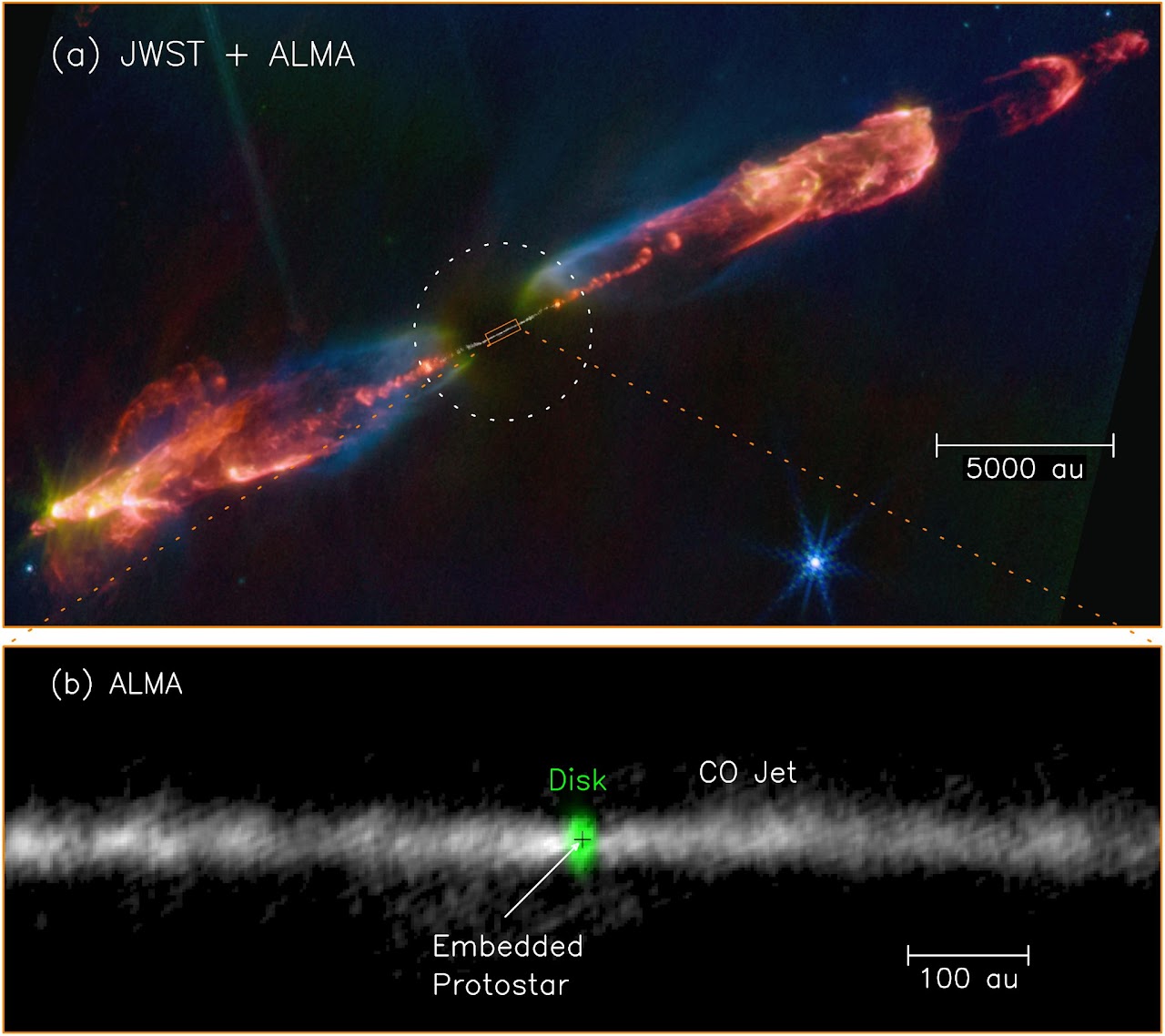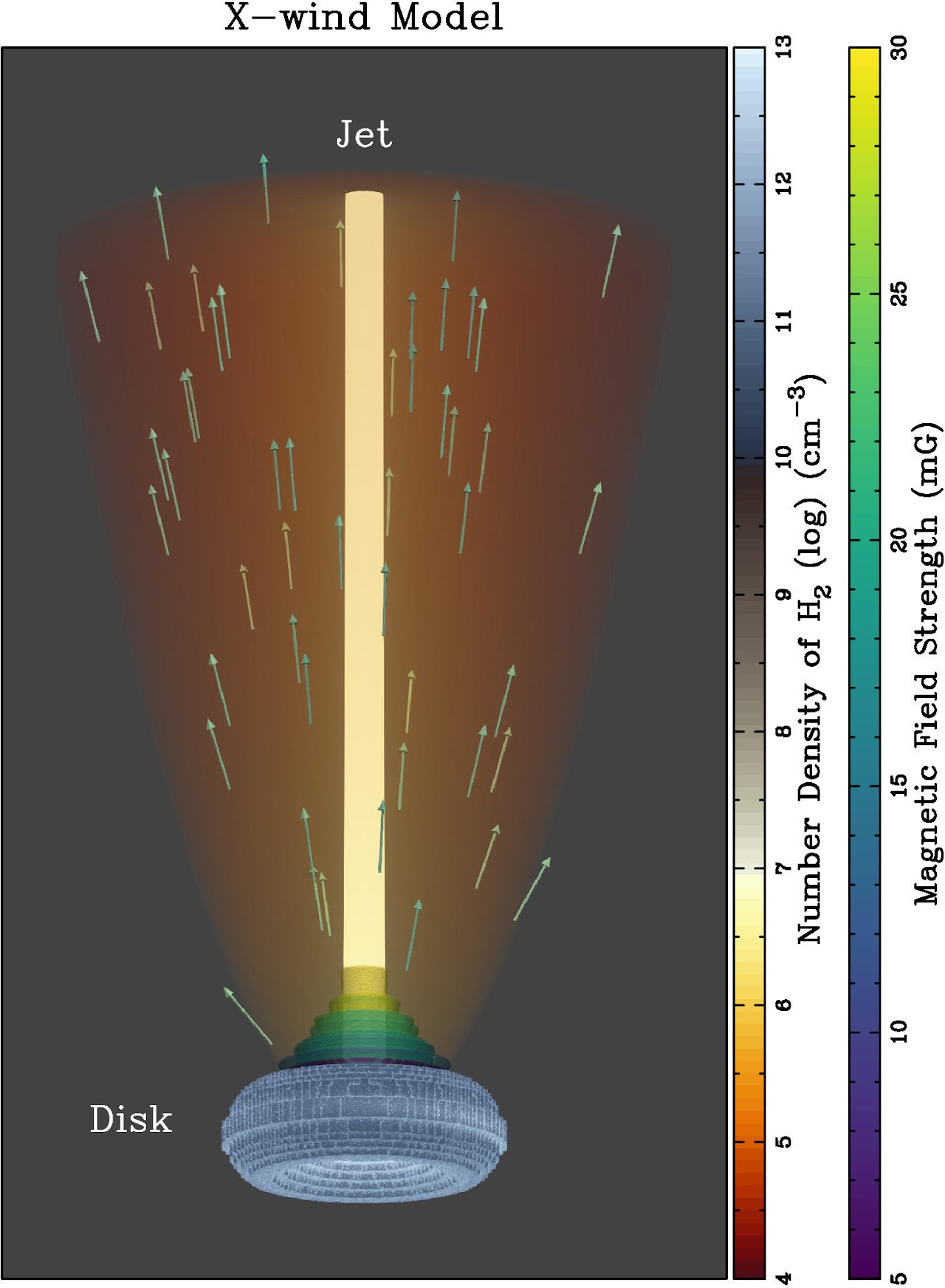In the universe, stars and planets don’t just appear out of nowhere — their birth is like a long construction project. Around a young star, there is often a surrounding accretion disk made of gas and dust. Material within this disk continually rotates, clumps together, and eventually falls onto the star, allowing it to grow over time. However, this process faces a key challenge: if the material in the accretion disk spins too fast, it becomes difficult for it to fall toward the center. Astronomers have long suspected that jets — streams of gas shot out at high speeds from near the star — can carry away the excess rotational energy, making it easier for material to move inward. But the launching points of such jets lie extremely close to the star, tens of times closer than the Earth is to the Sun, and previous observations have not been sufficient to clearly resolve their details or confirm their origins. An international research team, led by Chin-Fei Lee at Academia Sinica Institute of Astronomy and Astrophysics (ASIAA), has used the Atacama Large Millimeter/submillimeter Array (ALMA) in Chile to observe an extremely young protostar system known as HH 211. This protostar is only about 35,000 years old, has just 6% of the Sun’s mass, and lies about 1,000 light-years away. It possesses a bright bipolar jet — and remarkably, this jet is among the very few known examples where a magnetic field has been detected, offering a rare opportunity to test magnetic field–driven ejection models. The observations show that the jet moves at over 100 kilometers per second, but rotates very slowly, with a specific angular momentum of only 4 au·km/s. Using conservation of angular momentum and energy, the team determined that the jet originates from the innermost edge of the accretion disk, just 0.02 astronomical units from the star — in excellent agreement with the theoretical X-wind model. This model describes how a magnetic field can act like a slingshot to hurl gas outward, and it predicts a magnetic field strength consistent with previous measurements. This discovery marks the first time the launch point of a magnetized jet has been pinpointed with such high precision, and directly confirms that jets are indeed the “plumbers” of star formation — removing the last bits of angular momentum from the accretion disk so that material can fall smoothly onto the star. In the future, such observations will not only help solve the mystery of how stars are born, but also improve our understanding of the early stages of planet formation — since planets are nurtured within these very same disks.
在宇宙中,恆星和⾏星並不是憑空誕⽣的,它們的形成更像是⼀場漫⾧⽽精密的「建築⼯程」。在年輕恆星的周圍,往往環繞著⼀圈由氣體與塵埃組成的吸積盤,其中的物質不斷旋轉、聚集,最後落⼊恆星,使它逐漸成⾧。 然⽽,這個過程⾯臨⼀個關鍵難題:如果吸積盤中的物質旋轉過快,就難以向中⼼掉落。科學家早就懷疑,⼀種從恆星附近⾼速噴出的噴流,能夠帶⾛物質的旋轉動能,幫助恆星繼續成⾧。⽬前的主流理論認為,噴流是藉由磁場的作⽤被「甩」出來的。然⽽,這些噴流的發 射地點極為接近恆星,距離⽐地球到太陽⼩上數⼗倍,過去的觀測仍不⾜看清細節及確認。 由中央研究院天⽂及天⽂物理研究所(ASIAA)李景輝特聘研究員領導的國際團隊,近期利⽤位於智利⾼原的阿塔卡瑪⼤型毫⽶及次毫⽶波陣列(ALMA),觀測了⼀個名為 HH 211 的超年輕原恆星系統。這顆原恆星年齡僅約 3.5 萬年,質量只有太陽的 6%,距離地球約 1000 光年。它擁有⼀股明亮的雙極噴流,更難得的是,這股噴流是極少數能被偵測到帶有磁場的例⼦,因此為驗證磁場驅動的噴發模型提供了絕佳機會。 觀測結果顯⽰,噴流速度每秒超過 100 公⾥,但旋轉速度⾮常慢,單位質量角動量(specific angular momentum)僅 4 au·km/s。根據⾓動量與能量守恆的推算,團隊判斷噴流源⾃吸積盤最內側、距離恆星僅 0.02 個天⽂單位的位置——這與理論上的 X-wind 模型⾼度吻合。該模型描述了磁場如何像彈⼸般將氣體甩出,並且預測噴流的磁場強度與先前的測量值⼤抵⼀致。 這項發現⾸次以如此⾼精度鎖定了帶有磁場的噴流發射地點,並直接證實了噴流確實是恆星成⾧的「排⽔⼯」,負責清除吸積盤中最後的⾓動量,讓物質順利落向恆星。未來,這類觀測不僅有助於解開恆星誕⽣之謎,也能幫助我們理解⾏星形成的早期階段——因為⾏星正是在這些吸積盤中孕育⽽⽣的。

